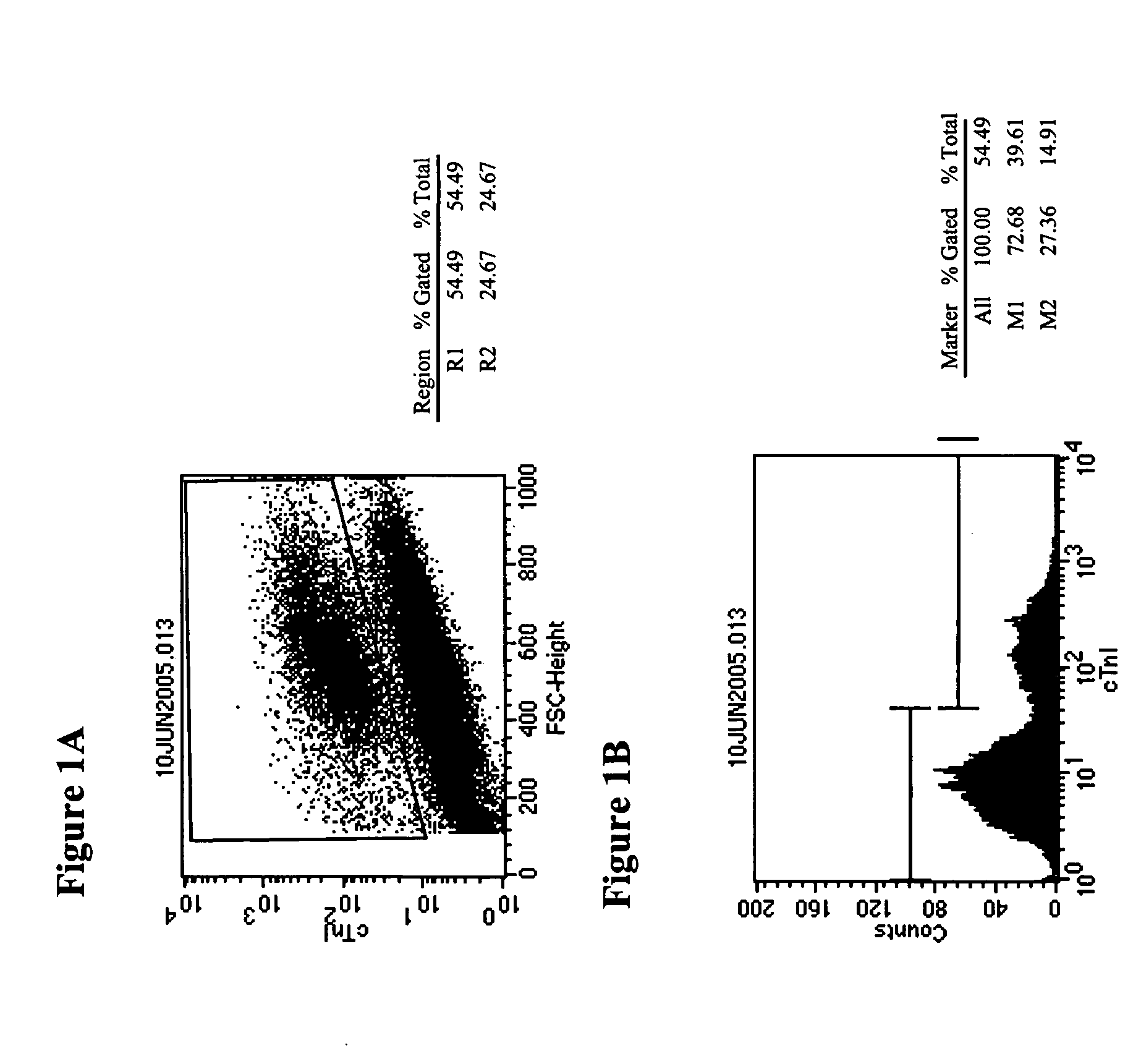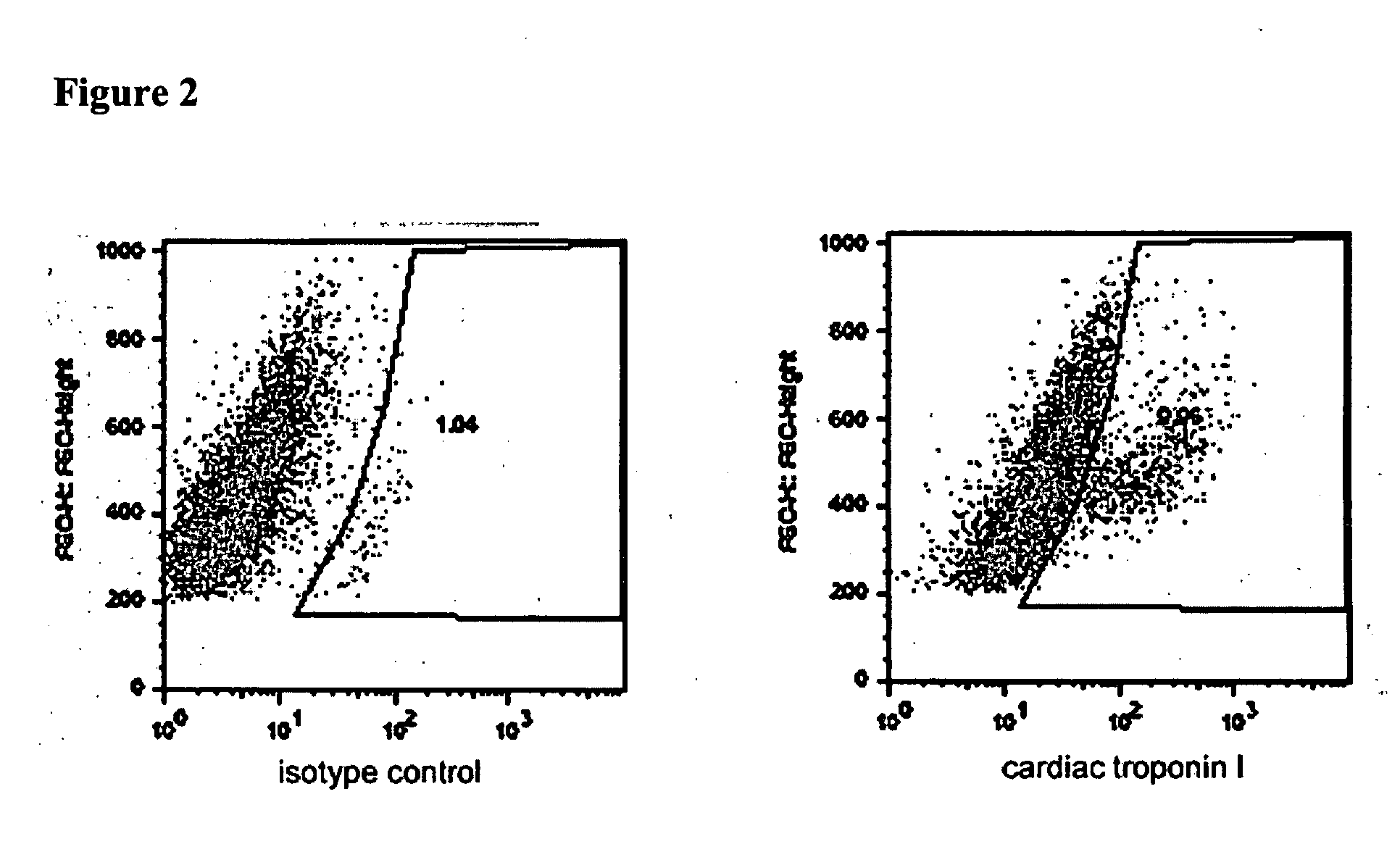Differentiation of primate pluripotent stem cells to cardiomyocyte-lineage cells
a technology of cardiomyocytes and stem cells, applied in the field of invitro differentiation of primate pluripotent stem cells into cardiomyocyte-lineage cells, can solve the problems of not being able to use commercially available products to help regenerate damaged tissue, and it is unclear if the contraction of striatal muscle cells can coordinate adequately with cardiac rhythm
- Summary
- Abstract
- Description
- Claims
- Application Information
AI Technical Summary
Benefits of technology
Problems solved by technology
Method used
Image
Examples
example 1
[0138] Three Factor Differentiation on Gelatin / FBS
[0139] Preparation of a gelatin / FBS-coated surface: 1 ml / well of 0.5% gelatin solution was added to the wells of a 6-well plate and incubated at 37° C. overnight. The gelatin solution was removed and sufficient 20% FBS-containing medium (e.g., 20% FBS (Sigma) in Knockout DMEM) was added to cover the surface of the wells. The plate incubated at 37° C. for a further 5-6 hours. Prior to addition of the human embryonic stem cells, the medium was removed from well.
[0140] Plating undifferentiated human embryonic stem cells for subsequent differentiation: 1 well of a 6 well plate of undifferentiated human embryonic stem cells was dissociated by a) removing medium; b) rinsing well once with PBS; and c) adding 1 ml of 0.25% trypsin / 500 mM EDTA solution. The well was incubated at 37° C. for 10 minutes and then triturated ten times with 1 ml pipettor. The well was examined under a microscope to see that the cells were dissociated completely. ...
example 2
[0149] Three Factor Direct Differentiation on Matrigel-coated surface
[0150] An aliquot of growth factor-reduced Matrigel (previously diluted 1:2 with cold Knockout DMEM and stored at −20 degrees). The Matrigel solution was diluted a further 1:15 with cold Knockout DMEM. Empty wells of a 6-well plate were coated with the diluted Matrigel solution at 1 ml / well, and the plate was incubated at room temperature for 4-5 hours. The Matrigel solution was removed, and human ES cells were plated as described below without a pre-rinsing of the wells.
[0151] Plating undifferentiated hES cells for subsequent differentiation: 1) The cells in 1 well of the 6 well plate of undifferentiated hES cells were dissociated by a) removing medium; b) rinsing well once with PBS; c) adding 1 ml of 0.05% trypsin / 500 mM EDTA solution. The well was incubated in a 37 degree incubator for 10 minutes. The cells were triturated with a pipettor until cells were dissociated completely. 2 ml of 20% FBS-containing medi...
example 3
[0158] Example of a Four-Phase Centrifugation Separation Method Enrichment
[0159] Cardiomyocytes were generated from hES cells of the H7 line by forming embryoid bodies for 4 days, and then proliferating on gelatin-coated plates for 17 days (5-aza-deoxy-cytidine and growth factors were not used). The cells were then dissociated using collagenase B, resuspended in differentiation medium. The cell suspension was then layered onto a discontinuous gradient of Percoll, and centrifuged at 1500 g for 30 min. Four fractions were collected: I. The upper interface; II. The 40.5% layer; III. The lower interface; IV. The 58.5% layer. The cells were washed and resuspended in differentiation medium. Cells for immunostaining were seeded into chamber slides at 104 cells per well, cultured for 2 or 7, and then fixed and stained.
[0160] Results are shown in Table 3. Percentage of MHC positive cells was determined by counting cells in 30 images from triplicate wells for each fraction and presented as ...
PUM
 Login to View More
Login to View More Abstract
Description
Claims
Application Information
 Login to View More
Login to View More - R&D
- Intellectual Property
- Life Sciences
- Materials
- Tech Scout
- Unparalleled Data Quality
- Higher Quality Content
- 60% Fewer Hallucinations
Browse by: Latest US Patents, China's latest patents, Technical Efficacy Thesaurus, Application Domain, Technology Topic, Popular Technical Reports.
© 2025 PatSnap. All rights reserved.Legal|Privacy policy|Modern Slavery Act Transparency Statement|Sitemap|About US| Contact US: help@patsnap.com



